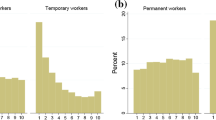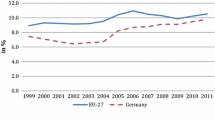Abstract
I use linked employer-employee data from the German Federal Statistical Office to estimate within-firm wage differentials between temporary workers with fixed-term contracts and workers with permanent contracts in the context of dual internal labor markets. Wage-tenure profiles of permanent workers are estimated separately for each firm to obtain a proxy for the prevalence of internal labor markets. Temporary workers earn significantly lower wages in firms with steeper wage-tenure profiles. This finding is consistent with the segmentation in a primary permanent workforce with high wages and a secondary temporary workforce with low wages, if internal labor markets are more prevalent.

Similar content being viewed by others
Notes
Note that even though compensating wage theory and non-shirking efficiency wage models imply lower wages for the permanent workforce if the layoff probability is reduced via the use of FTCs, they do not imply higher wages for workers with FTCs. For example in the standard non-shirking efficiency wage model (Shapiro and Stiglitz 1984) workers have unemployment as an outside option with lower income than in employment, which induces work effort. Dual labor markets imply a second outside option for primary permanent workers, namely employment in the secondary workforce with FTCs. The larger the wage disadvantage for workers with FTCs, the larger would be the incentive for permanent workers to provide work effort and not to get fired from the primary workforce. Consequently, firms with dual ILM have an incentive to pay workers with FTCs lower wages than workers with permanent contracts.
Note that even in deferred compensation models (e.g., Lazear 1979), in which individual productivity does not necessarily increases over a worker’s career, workers with a higher productivity should still earn higher wage levels than workers with lower productivity - in other words, deferred compensation implies wage redistribution from low to high tenure but not from high to low productive workers.
See the homepage of the Research Data Centre of the German Federal Statistical Office (http://www.forschungsdatenzentrum.de/en/) for detailed information about the data set.
As the chosen threshold values with respect to firm size and the number of observations are quite arbitrary, I performed several robustness checks for different samples. The main findings are quite robust to this sample restriction, as long as we still focus on larger firms with sufficient workers to estimate earnings functions within firms.
References
Boockmann B, Hagen T (2008) Fixed-term contracts as sorting mechanisms: evidence from job durations in West Germany. Labour Econ 15:984–1005
Booth AL, Francesconi M, Frank J (2002) Temporary jobs: stepping stones or dead ends? Econ J 112:F189–F213
Brown S, Sessions JG (2003) Earnings, education, and fixed-term contracts. Scott J Polit Econ 50:492–506
Brown S, Sessions JG (2005) Employee attitudes, earnings, and fixed-term contracts: international evidence. Rev World Econ 141:296–317
Doeringer PB, Piore MJ (1971) Internal labor markets and manpower analysis. Heath, Lexington
Gebel M, Giesecke J (2009) Labour market flexibility and inequality: the changing risk patterns of temporary employment in West Germany. J Labour Mark Res 42:234–251
Gibbons R, Waldman M (1999) Careers in organizations: theory and evidence. Handb Labor Econ 3:2373–2437
Güell M, Petrongolo B (2007) How binding are legal limits? Transitions from temporary to permanent work in Spain. Labour Econ 14:153–183
Hafner H-P, Lenz R (2008) The German Structure of Earnings Survey: methodology, data access and research potential. Schmollers Jahr 128:489–500
Hagen T (2002) Do temporary workers receive risk premiums? Assessing the wage effects of fixed-term contracts in West Germany by a matching estimator compared with parametric approaches. LABOUR 16:667–705
Hutchens RM (1989) Seniority, wages and productivity: a turbulent decade. J Econ Perspect 3:49–64
Lazear EP (1979) Why is there mandatory retirement? J Polit Econ 87:1261–1284
Lazear EP (1999) Personnel economics: past lessons and future directions. J Labor Econ 17:199–236
Leontaridi MR (1998) Segmented labour markets: theory and evidence. J Econ Surv 12:63–101
Leontaridi RM (2002) Career, experience and returns to human capital: is the dual labour market hypothesis relevant for the UK? Res Econ 56:399–426
Mertens A, McGinnity F (2004) Wages and wage growth of fixed-term workers in East and West Germany. Appl Econ Q 50:139–163
Mertens A, McGinnity F (2005) A “two-tier” labour market for fixed-term jobs? Evaluating evidence from West Germany using quantile regression. Schmollers Jahr 125:75–85
Mertens A, Gash V, McGinnity F (2007) The cost of flexibility at the margin. Comparing the wage penalty for fixed-term contracts in Germany and Spain using quantile regression. LABOUR 21:637–666
OECD (2002) Employment Outlook 2002, Chapter 3 “Taking the measure of temporary employment”. OECD, Paris, pp 127–185
Pfeifer C (2009) Fixed-term contracts and employment adjustment – An empirical test of the core-periphery hypothesis using German establishment data. Econ Rec 85:92–107
Pfeifer C (2012) Fixed-term contracts and wages revisited using linked employer-employee data. J Labour Mark Res 45:171–183
Rebitzer JB, Taylor LJ (1991) A model of dual labor markets when product demand is uncertain. Q J Econ 106:1373–1383
Saint-Paul G (1991) Dynamic labor demand with dual labor markets. Econ Lett 36:219–222
Shapiro C, Stiglitz JE (1984) Equilibrium unemployment as a worker discipline device. Am Econ Rev 74:433–444
Taubman P, Wachter ML (1986) Segmented labor markets. Handb Labor Econ 2:1183–1217
Author information
Authors and Affiliations
Corresponding author
Rights and permissions
About this article
Cite this article
Pfeifer, C. A Note on Dual Internal Labor Markets and Wages of Temporary Workers: Evidence from Linked-Employer-Employee Data. J Labor Res 35, 133–142 (2014). https://doi.org/10.1007/s12122-013-9173-1
Published:
Issue Date:
DOI: https://doi.org/10.1007/s12122-013-9173-1




